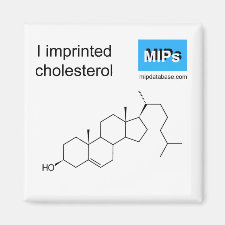
Authors: Shin MJ, Shin YJ, Shin JS
Article Title: Cholesterol recognition system by molecular imprinting on self-assembled monolayer.
Publication date: 2018
Journal: Colloids and Surfaces A: Physicochemical and Engineering Aspects
Volume: 559
Page numbers: 365-371.
DOI: 10.1016/j.colsurfa.2018.09.078
Alternative URL: http://www.sciencedirect.com/science/article/pii/S092777571831238X
Abstract: In this study, the molecular imprinting technique and self-assembled monolayer technique were combined to increase the recognition ability of cholesterol. A self-assembled monolayer with 4-mercaptophenol and benzenethiol was formed on a gold plate, and the reaction of cholesteryl chloroformate with the phenol group in the 4-mercaptophenol was followed. This layer was then coated with poly(methyl methacrylate) (PMMA). In order to expose the cholesterol buried under the coating, the partial upper part of the coated PMMA was then removed by stroking the coated plate in acetone solvent. The molecular imprinted site was prepared by hydrolysis of the carbonate bond and extraction of the hydrolyzed cholesterol. This gold plate was used as a working electrode to test the recognition ability for cholesterol. The result showed that the plate obtained good recognition ability for cholesterol compared with cholic acid. The ratio of 4-mercaptophenol to benzenethiol was a very important factor in the ability to recognize cholesterol. Regulating the thickness of the coated PMMA was also one of the important factors to increase the ability to recognize cholesterol
Template and target information: cholesterol
Author keywords: molecular imprinting, self-assembled monolayer, molecular recognition, coating, cholesterol



Join the Society for Molecular Imprinting

New items RSS feed
Sign-up for e-mail updates:
Choose between receiving an occasional newsletter or more frequent e-mail alerts.
Click here to go to the sign-up page.
Is your name elemental or peptidic? Enter your name and find out by clicking either of the buttons below!
Other products you may like:
 MIPdatabase
MIPdatabase









